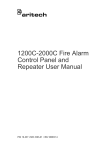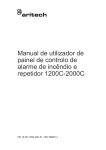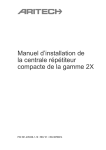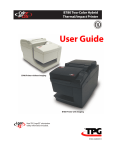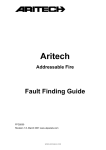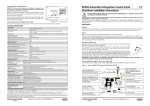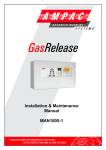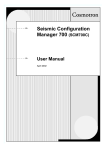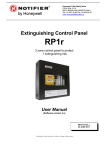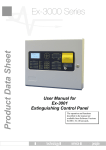Download FEC403EN User Manual - Utcfssecurityproductspages.eu
Transcript
FEC403EN User Manual P/N 10-4101-505-2FC1-01 • ISS 22JAN15 Copyright Trademarks and patents Manufacturer © 2015 UTC Fire & Security. All rights reserved. The FEC403EN name and logo are trademarks of UTC Fire & Security. UTC CCS Manufacturing Polska Sp. Z o.o. Ul. Kolejowa 24. 39-100 Ropczyce, Poland Authorized EU manufacturing representative: UTC Fire & Security B.V. Kelvinstraat 7, 6003 DH Weert, Netherlands Version This document applies to FEC403EN version 3.0 Certification 2012/19/EU (WEEE directive): Products marked with this symbol cannot be disposed of as unsorted municipal waste in the European Union. For proper recycling, return this product to your local supplier upon the purchase of equivalent new equipment, or dispose of it at designated collection points. For more information see: www.recyclethis.info. 2006/66/EC (battery directive): This product contains a battery that cannot be disposed of as unsorted municipal waste in the European Union. See the product documentation for specific battery information. The battery is marked with this symbol, which may include lettering to indicate cadmium (Cd), lead (Pb), or mercury (Hg). For proper recycling, return the battery to your supplier or to a designated collection point. For more information see: www.recyclethis.info. Contact information For contact information, see www. utcfssecurityproducts.eu. Content Important information ii Limitation of liability ii Agency compliance ii European regulations for construction products iii User guide 1 Keyboard layout 1 Access levels 2 Starting up the panel 2 LED indicators, buttons and acoustic indicators 2 Operating modes 10 In the event of fire or fault 14 General 14 Extinguishing 14 Troubleshooting, maintenance, support 15 Troubleshooting 15 Maintenance 17 Contacting technical support 17 FEC403EN User Manual i Important information Limitation of liability Installation in accordance with this manual, applicable codes, and the instructions of the authority having jurisdiction is mandatory. UTC Fire & Security shall not under any circumstances be liable for any incidental or consequential damages arising from loss of property or other damages or losses owing to the failure of UTC Fire & Security products beyond the cost of repair or replacement of any defective products. UTC Fire & Security reserves the right to make product improvements and change product specifications at any time. While every precaution has been taken during the preparation of this manual to ensure the accuracy of its contents, UTC Fire & Security assumes no responsibility for errors or omissions. Agency compliance This product has been designed according to the following standards: • EN54-2, EN54-4 • EN60950-1 • EN12094-1 • ANPI TN121 • EMC Immunity EN50130-4 • EMC Emissions EN61000-6-3, EN61000-3-2, EN61000-3-3 The EN12094-1 standard includes basic and optional requirements. The optional requirements this product meets are: Table 1: EN12094-1 optional requirements Clause Description 4.17 Extinguishing agent release delay 4.18 Signal representing the flow of agent 4.19 Monitoring of the status of components 4.20 Emergency hold device (mode A or B) 4.23 Manual only mode 4.24 Triggering signals to equipment within the system 4.26 Triggering signals to equipment outside the system 4.27 Emergency abort device 4.30 Activation of alarm device with different signals ii FEC403EN User Manual European regulations for construction products This section includes both regulatory information and a summary on the declared performance according to the Construction Products Regulation 305/2011. For detailed information refer to the product Declaration of Performance (DoP). Table 2: Certification Certification body 1134 Manufacturer UTC CCS Manufacturing Polska Sp. Z o.o. Ul. Kolejowa 24. 39-100 Ropczyce, Poland Authorized EU manufacturing representative: UTC Fire & Security B.V., Kelvinstraat 7,6003 DH Weert, The Netherlands Year of first CE marking 09 Declaration of Performance number 360-3319-0199 EN 54 EN12094-1, EN54-2, EN54-4, Environmental Class A Product identification See model number on product identification label Intended use See DoP point 3 Essential characteristics See DoP point 9 FEC403EN User Manual iii iv FEC403EN User Manual User guide Keyboard layout Figure 1: Keyboard layout 1. Fire LEDs (general / zone) 2. Fault LEDs (general / zone) 3. Maintenance LED 19. Gas flow LEDs (Active / Fault) C. Test button 4. Fault return LED 20. Door monitor LEDs (Active / 5. Supply fault LED 6. System fault LED 21. FBRIG delay LED F. Sounder 1 stop button 7. Out of service LED 22. FBRIG start LEDs (Active / G. FBRIG start button 8. Supply on LED 9. Disable LED (general) 10. Test LED 11. Manual mode LED 12. Start MCP fault LED 18. Gas pressure LEDs (Active / Fault) Fault) Fault) 23. Sounder 1 stop LEDs (Active / Fault) 24. Sounder 2 stop LEDs (Active B. Disable extinguishing button D. Disable button (general) E. Sounder 2 stop button H. FBRIG delay button J. Silence Buzzer button K. Reset button L. Access key (level 1 / level 2) / Fault) 13. Released LED 25. Silence buzzer LED 14. Extinguishing activated LED 26. Reset LED 15. Extinguishing fault/disable 27. Auxiliary disabled LED LED A. Zone buttons (Z1, Z2, Z3) 28. Warning sign fault LED 16. Hold MCP LEDs (Active/Fault) 29. Evacuate sign fault LED 17. Abort MCP LEDs 30. Released sign fault LED (Active/Fault) FEC403EN User Manual 1 Access levels In accordance with EN54 guidelines the FEC403EN uses a restricted access protocol for increased security. Access levels are controlled via the access key (see Figure 1). Access levels are as follows: Access level 1 When the key is turned to the locked position access level 1 is active. This access level allows activation of the Silence Buzzer button and cancellation of any programmed fire brigade delay via the FBRIG delay button. No other system controls are available in access level 1. Access level 2 When the key is turned to the unlocked position access level 2 is active. This access level allows full control of the extinguishing control panel and features and is reserved for the user responsible for operating the system. Starting up the panel The panel can start up in one of two ways: normal startup and a special startup sequence used after an internal fault has been detected by the panel (in accordance with EN12094-1). The EN12094-1 fault startup is indicated by the following: • • • General fault LED (flashing) System fault LED (slow flash) Reset LED (flashing) When the panel is in this condition pushing the reset button will restart the panel. If the panel continues to detect a fault the startup sequence will not be completed and sytem fault LED will be activated (constant). LED indicators, buttons and acoustic indicators See Figure 1 for the location of all items. A reference in square brackets - for example [9] - refers to the item listing in this figure. LED indicators 1. Fire (general) Two red LEDs indicate an alarm in the system. Flashing LEDs indicate that a detector has activated the alarm. Constant LEDs indicate that a manual call point has activated the alarm. 2 FEC403EN User Manual 1. Fire (zone) The zone in alarm is indicated by a red LED above the zone button (zone 1, 2 or 3). 2. Fault (general / zone) A constant yellow LED indicates that the zone is either disabled or in test mode. A flashing yellow LED indicates a fault. The zone in fault is indicated by a yellow LED above the corresponding zone button (zone 1, 2 or 3). Test or disabled status can be determined by the general Disable [9] or Test [10] LEDs described later in this section. 3. Maintenance This feature is for installations using Clean-Me enabled detectors only. A constant yellow LED indicates that detector maintenance is required. The detector zone is displayed when the Silence Buzzer button [J] is pressed for more than three seconds. 4. Fault return A slow flashing yellow LED indicates a fault on the input. A fast flashing yellow LED indicates that the input has been activated. 5. Supply fault A constant yellow LED indicates a battery or mains power supply fault. As a single LED is used to indicate both types of fault ensure that both mains and battery fuses are checked when a supply fault is indicated. 6. System fault A constant yellow LED indicates that a software fault in the control panel has been detected. 7. Out of service A constant yellow LED indicates that the control panel has lost power and battery voltage is below the minimum required value (22 VDC). 8. Supply on A constant green LED indicates that the control panel is powered up correctly by either the mains power supply or battery. 9. Disable (general) A constant yellow LED indicates that one or more features of the control panel have been disabled. The corresponding LED for the disabled feature will also be activated. 10. Test (general) A constant yellow LED indicates that one or more features of the control panel are in test mode. The corresponding LED for the feature being tested will also be activated. FEC403EN User Manual 3 11. Manual mode A constant yellow LED indicates that the control panel is in manual mode. Manual mode may only be activated using an external key-operated manual call point. In manual mode extinguishing can only be activated by a start manual call point - the extinguishing process will not start automatically if a fire alarm is detected in zones 1 and 2. 12. Start MCP fault A constant yellow LED indicates that the start extinguishing manual call point has been disabled. A slow flashing yellow LED indicates that there is a fault with the start extinguishing manual call point line supervision (open or short-circuit). A fast flashing yellow LED indicates that the start extinguishing manual call point has been activated. 13. Released A constant red LED indicates that the extinguishing agent has been released. A flashing red LED indicates that the actuators have been activated and the panel is waiting for confirmation (if the gas flow switch is configured). 14. Extinguishing activated A flashing red LED indicates a pre-alarm (zone 1 or zone 2 is in alarm). A constant red LED indicates an activated state (zone 1 and zone 2 are in alarm or a start manual call point has been activated) and that any configured extinguishing delay is running. Note: A delay of between 5 and 60 seconds may be programmed during installation for the extinguishing agent release 15. Extinguishing fault / disable A constant yellow LED indicates that the automatic extinguishing process has been disabled via the control panel. A flashing yellow LED indicates a fault in the extinguishing actuator circuitry. 16. Hold MCP (Active / Fault) A fast flashing yellow LED (ACT) indicates that the extinguishing process has been delayed by a hold extinguishing manual call point. A flashing yellow LED (FLT) indicates a fault. 17. Abort MCP (Active / Fault) A fast flashing yellow LED (ACT) indicates that the extinguishing process has been cancelled by an abort extinguishing manual call point. A flashing yellow LED (FLT) indicates a fault. 18. Gas pressure (Active / Fault) A fast flashing yellow LED (ACT) indicates that the gas pressure input has been activated (the pressure in the gas bottles is low). For some installations this input is connected to the weight switch. 4 FEC403EN User Manual A flashing yellow LED (FLT) indicates a fault in the line supervision (open or short-circuit). A constant yellow LED (FLT) indicates that the feature has been disabled or is in test mode (check the general Disable [9] and general Test LEDs [10] for verification). 19. Gas flow (Active / Fault) A fast flashing yellow LED (ACT) indicates that the gas flow input has been activated (the gas is flowing from the bottles). A flashing yellow LED (FLT) indicates a fault in the line supervision (open or short-circuit). A constant yellow LED (FLT) indicates that the feature has been disabled or is in test mode (check the general Disable [9] and general Test LEDs [10] for verification). 20. Door monitor (Active / Fault) A fast flashing yellow LED (ACT) indicates that the door monitor input has been activated. In standby (with the system in automatic mode) the input is activated if the monitored door is open, or (if the system is in manual mode) if the door is closed. In activated or released state the input is activated if the door is open. A flashing yellow LED (FLT) indicates a fault in the line supervision (open or short-circuit). 21. FBRIG delay A constant yellow LED indicates that any programmed fire brigade delay has been activated. Note: A delay of between 1 and 10 minutes may be programmed for this feature during installation. 22. FBRIG start (Active / Fault) A constant red LED (ACT) indicates that the fire brigade output has been activated (the call fire brigade procedure has started). A flashing yellow LED (FLT) indicates a fault in the line supervision (open or short-circuit). A constant yellow LED (FLT) indicates that the feature has been disabled or is in test mode (check the general Disable [9] and general Test LEDs [10] for verification). 23. Sounder 1 stop (Active / Fault) A constant red LED (ACT) indicates that the first stage sounder (pre-alarm) has been activated (zone 1 or zone 2 is in alarm). A flashing yellow LED (FLT) indicates a fault in the line supervision (open or short-circuit). A constant yellow LED (FLT) indicates that the feature has been disabled or is in test mode (check the general Disable [9] and general Test LEDs [10] for verification). FEC403EN User Manual 5 24. Sounder 2 stop (Active / Fault) A constant red LED (ACT) indicates that the second stage sounder (alarm) has been activated (zone 1 and zone 2 are in alarm or a start manual call point has been activated). A flashing yellow LED (FLT) indicates a fault in the line supervision (open or short-circuit). A constant yellow LED (FLT) indicates that the feature has been disabled or is in test mode (check the general Disable [9] and general Test LEDs [10] for verification). 25. Silence buzzer A constant yellow LED indicates that the internal buzzer has been silenced. 26. Reset A constant yellow LED indicates that the reset button is blocked by an activation delay (described later). 27. Auxiliary disabled A constant yellow LED indicates that the auxiliary output has been disabled. 28. Warning sign fault A flashing yellow LED indicates that there is a fault with the illuminated warning sign line supervision (open or short-circuit). A constant LED indicates that the sign is disabled or in test mode (check the general Disable [9] and general Test LEDs [10] for verification). 29. Evacuate sign fault A flashing yellow LED indicates that there is a fault with the illuminated evacuate sign line supervision (open or short-circuit). A constant LED indicates that the sign is disabled or in test mode (check the general Disable [9] and general Test LEDs [10] for verification). 30. Released sign fault A flashing yellow LED indicates that there is a fault with the illuminated extinguishing released sign line supervision (open or short-circuit). A constant LED indicates that the sign is disabled or in test mode (check the general Disable [9] and general Test LEDs [10] for verification). Buttons A. Zones (Z1, Z2, Z3) Enables / disables a zone. A disabled zone is indicated by a constant yellow LED. B. Disable extinguishing Used with the disable sequence described in Disable (general). Disables the extinguishing area and prevents activation of the extinguishing process. Caution: If extinguishing has been activated via a manual call point or if the panel is in activated mode the extinguishing process cannot be disabled. 6 FEC403EN User Manual A fault on the hold extinguishing manual call point or the abort extinguishing manual call point will automatically disable the actuator. If the actuator is disabled automatically due to a manual call point fault it will be enabled after resetting the control panel (assuming the fault has been fixed). If the actuator has been disabled manually the disabled state is not changed by resetting the control panel. C. Test This feature can only be used when the control panel is in standby mode. Tests a control panel controlled feature or component. Limited testing is available in access level 1. What can be tested with level 1 access: • • All control panel LEDS Internal buzzer Access level 1 test procedure: 1. Press the Test button and keep it pressed. 2. To terminate the test depress the Test button. While the test is active (the Test button is pressed) all control panel LEDS will be lit and the internal buzzer will sound continuously. What can be tested with level 2 access: • • • • • • • • • • Zones (zone 1, 2 or 3) Start extinguishing manual call point Hold extinguishing manual call point Abort extinguishing manual call point Pressure switch Gas flow switch First stage sounder (pre-alarm) Second stage sounder (alarm) Fire brigade Illuminated warning signs Access level 2 test procedure: To test zone 1, zone 2, zone 3, extinguishing, fire brigade and stage 1 or stage 2 sounders: 1. Press the Test button (marked "C" in Figure 1) and the button of the function / feature to be tested at the same time (for example press Test and the Z1 button together to test zone 1). 2. Repeat this process to terminate the test. For the remaining level 2 test options: 1. Press the Test button (marked "C" in Figure 1) for 3 seconds and then select the feature / component to be tested by pressing the Test button repeatedly until the LED for the desired feature / component flashes quickly. FEC403EN User Manual 7 2. To activate the test for the selected feature / component turn the keyswitch to level 1 and then back to level 2. The corresponding output / input will be activated for 3 seconds after which the system will be reset automatically. While the test is active the feature / component LEDs are ON (constant). There is no acoustic signal. D. Disable (general) Disables a control panel controlled feature or component. Level 2 access is required. Note: This feature can be used when the control panel is in standby, fault or prealarm mode. It cannot be used when the control panel is in alarm mode The control panel allows primary function disable and secondary function disable options. Table 3: Primary and secondary disable functions Primary disable functions Secondary disable functions Zone 1, zone 2 and zone 3 Start extinguishing manual call point Extinguishing Pressure switch Fire brigade Gas flow switch Stage 1 or stage 2 sounders (actuators will be automatically disabled) Illuminated warning signs Auxilliary output To disable a primary function: 1. Press the general Disable button (marked "D" in Figure 1) and the button of the function / feature to be disabled at the same time (for example press Disable and the Z1 button together to disable zone 1). Repeat this process to enable a disabled primary function. For further details on disabling extinguishing see the “Disable extinguishing” section. To disable a secondary function 1. Press the Disable button (marked "D" in Figure 1) for 3 seconds and then select the feature / component to be disabled by pressing the Disable button repeatedly until the LED for the desired feature / component flashes quickly). 2. To activate the disable option for the selected feature / component turn the keyswitch to level 1 and then back to level 2. To enable a feature disabled in this way repeat the above procedure. The disabled state is not changed by resetting the control panel. While the feature / component is disabled the general disable and feature / component LEDs are ON (constant). Note: If a disabled feature or component is enabled in alarm mode any programmed extinguishing delay will be activated before the extinguishing agent is released 8 FEC403EN User Manual E. Sounder 2 stop Stops the second stage (alarm) sounder The sounder is restarted by pressing the button again. F. Sounder 1 stop Stops the first stage (pre-alarm) sounder. The sounder is restarted by pressing the button again. G. FBRIG start Calls the fire brigade (level 2 access required). If enabled the call fire brigade procedure will be activated automatically in the event of a fire alarm. Note: If there is no fire alarm the call fire brigade procedure cannot be started manually H. FBRIG delay Starts the programmed fire brigade delay, after which the call fire brigade procedure will be activated. A constant yellow LED indicates that the programmed fire brigade delay has been activated (the fire brigade will be called after the delay). The delay can be cancelled by pressing the FBRIG delay button (the fire brigade will be called immediately). J. Silence buzzer Silences the internal buzzer. K. Reset Resets the system. Any fault or alarm that has not been resolved will be highlighted again. The control panel Reset button is blocked when extinguishing has been activated until the extinguishing agent is released. During this time the extinguishing process can only be cancelled using the abort extinguishing manual call point. The delay from activation to release is programmed at installation (maximum 30 minutes). During the activation delay the control panel can only be reset after the programmed reset delay has completed (the constant yellow LED for reset is off). L. Access key See the “Access levels” section. Acoustic indicators The control panel uses the following acoustic indicators: • Alarm indicator (constant internal buzzer). • Fault indication (intermittent internal buzzer). FEC403EN User Manual 9 Operating modes Standby mode When the control panel is in standby mode only the Supply on LED is activated. There is no acoustic indicator. Pre-alarm mode (zone 1 or zone 2 in alarm) A pre-alarm is indicated as follows: • • • • • • • • • The general Fire LEDs are activated. The general fire relay is activated. The corresponding zone Fire LED is activated (for example - first alarm in zone 1, confirmed alarm in zone 2: zone 1 LED flashing, zone 2 LED steady). The Activated LED is activated (flashing). The internal buzzer is activated (constant). The stage 1 sounder and associated LED are activated. The illuminated warning sign is activated. The auxiliary output relays are activated (if enabled). The call fire brigade / call fire brigade delay is activated (if set) * * If configured to stage 1 alarm. Control panel operation in Pre-alarm mode The following operations can be performed in this mode: • Silence the internal buzzer (press the Silence Buzzer button). • Silence the first stage sounder (press the Sounder 1 stop button). Restart the sounders by pressing the button again. • Reset the system (press the Reset button). Caution: Access level 2 is required to silence first stage sounders and reset the control panel. It is not recommended to reset the system until the location and cause of the alarm has been established Alarm mode (zone 1 and zone 2 in alarm or a manual call point activated) An alarm in zones 1 and 2 is indicated as follows: • • • • • • • • • • The general Fire LEDs are activated. The corresponding zone Fire LEDs are activated. The Activated LED is activated (constant). The internal buzzer is activated (constant). The stage 2 sounder and associated LED are activated. The illuminated evacuate sign is activated. The extinguishing agent release delay is activated (if configured). The door monitor timer is cancelled (if configured). The call fire brigade / call fire brigade delay is activated (if set). The Reset button is blocked and associated LED is activated. Control panel operation in Alarm mode (zone 1 and zone 2 in alarm) 10 FEC403EN User Manual The following operations can be performed in this mode: • • Silence the internal buzzer (press the Silence Buzzer button). Silence the second stage sounders (press the Sounder 2 stop button) if the panel is in released state. Restart the sounders by pressing the button again. Requires level 2 access. Alarm mode (zone 3 in alarm) An alarm in zone 3 is indicated as follows: • • • • • • • • • The general Fire LEDs are activated. The zone 3 Fire LED is activated. The internal buzzer is activated (constant). The stage 1 sounder and associated LED are activated. The illuminated warning sign is activated. * The two stage 1 alarm relays are activated (if auxiliary outputs are enabled). * The call fire brigade / call fire brigade delay is activated (if set). * The general fire alarm relay is activated. The zone 3 fire alarm relay is activated. * Subject to configuration. Control panel operation in Alarm mode (zone 3 in alarm) The following operations can be performed in this mode: • • Silence the first stage sounder (press the Sounder 1 stop button). Restart the sounders by pressing the button again. Reset the system (press the Reset button). Caution: Access level 2 is required to silence first stage sounders and reset the control panel. It is not recommended to reset the system until the location and cause of the alarm has been established. Fault mode Faults are indicated as follows: • • • LED indicators: general fault (flashing LED), zone fault (flashing LED), power fault (constant LED) or sounder fault (flashing LED). Acoustic indicator (intermittent). Output activation of the fault relay (potential free). Control panel operation in Fault mode The following operations can be performed while the control panel is in fault mode: • • Silence the internal buzzer (press the Silence Buzzer button). Reset the system (press the Reset button). Note: Investigate the cause of the fault and make any required repairs before resetting the system. FEC403EN User Manual 11 Disabled mode The control panel allows each zone and selected system features and components to be disabled and enabled independently. Caution: When a zone is disabled, none of the indications or events that may occur within the zone will be reported to the control panel. Disabled mode is indicated as follows: • • • LED indicators for general disable (flashing) and / or zone disable (constant). LED indicator for the disabled feature / component (constant). Acoustic indicator (intermittent). Control panel operation in Disabled mode See the Disable procedures outlined in “LED indicators, buttons and acoustic indicators” on page 2. Test mode The control panel allows each zone and selected system features and components to be tested independently. Test mode is indicated as follows: • • • 1. LED indicator for Test (constant). 2. LED indicator for the feature / component being tested (constant). 3. Acoustic indicator (intermittent - level 1 test only). Control panel operation in Test mode See the Test procedures outlined in “LED indicators, buttons and acoustic indicators” on page 2. Out of service mode The control panel enters into an out-of-service mode only when the mains power is out and the battery voltage is below 22 V. In this mode there is no alarm or fault warning. • • • LED indicators: Fault (flashing) and Out of Service (constant). Acoustic indicator (intermittent). Activation of outputs: activation of fault relay (potential free) Caution: When mains power is re-established the control panel returns to its former status. If the mains failure lasts for an extended time, the panel will indicate Out of Service when the battery voltage reaches 19 V. All panel operation will then stop. 12 FEC403EN User Manual Control panel operation in Out of service mode No controls are available in this mode. Caution: To prevent possible damage to batteries it is recommended that the control panel is disconnected from the batteries when in Out of service mode. FEC403EN User Manual 13 In the event of fire or fault General Caution: You must be familiar with the control panel LED indicators and buttons in order to be able to react accordingly Keep calm In an alarm situation, the control panel activates the sounders to warn users about the event. It is very important to keep calm, regardless the acoustic signal, so the right decisions may be taken. Keypad access To operate the control panel keypad the access key must be set to level 2 (keypad unlocked). Press the Silence Buzzer button The user may press the Silence Buzzer button to silence the internal buzzer. This will help to think about what to do under better conditions (sounders may also be stopped by pressing the corresponding sounder stop button). Identify the alarm cause The LED indicators on the front of the control panel will help to identify what kind of alarm or fault has caused the system to enter in the current state. Act Once the cause has been identified react according to the emergency plan that must be defined at every site. System reset Once the problem has been solved the system may be reset. Extinguishing If the two zones that are linked to an extinguishing area enter into an alarm mode, then the panel will automatically start the extinguishing process. If a delay has been programmed, there will be some time available to evacuate the room. The extinguishing process can be stopped by activating the abort extinguishing or the hold extinguishing manual call points. If the risk situation cannot be controlled the extinguishing process may be started by activating a start extinguishing manual call point (if an abort extinguishing manual call point has not been activated). 14 FEC403EN User Manual Troubleshooting, maintenance, support This section provides information to help you diagnose and solve various problems that may arise while configuring or using your UTC Fire & Security product. Caution: This product must be installed and maintained by qualified personnel adhering to all applicable standards and local authority laws. Troubleshooting Solutions to common problems can be found in the following table. Table 4: Troubleshooting common problems Problem Cause Action to be taken The service LED indicator is not on. The panel has no power. Check power supply (230 VAC). Check power supply fuse. Check battery. The general fault and power supply failure LED indicator is on and the buzzer is sounding intermittently. The panel has no power supply from the mains and is working with batteries. There is a battery failure. The voltage from the power supply is not correct (28V or 5V). The general fault and out of service LED indicators are on and the buzzer is sounding intermittently. The panel has no power supply from the mains and the battery is below 22 V (minimum working voltage). Check power supply (230 VAC). Check power supply fuse. Check battery connection. Check that battery voltage correct. Check battery charger voltage is 27.6 VDC Disconnect the battery and the power supply until the mains voltage or charged batteries can be supplied. Check the cable connection between the power supply and the PCB. The general fault, input/output and zone failure LED indicators are on (flashing) and the buzzer is sounding intermittently. The indicated zone / device has a fault. Check the end-of-line resistance of the zone. Check that there are no short or open circuits in the lines. Check that there are no inverted polarity detector connections. Check that there are no manual call points activated without a series resistance. The general disabled and zone disabled LED indicators are on and the buzzer is sounding intermittently. The indicated zone is disabled. To enable the zone, turn the key to the ON position and press the key of the disabled zone. The panel does not respond to the keypad. The keypad is disabled. To enable the keypad, turn the key to the ON position. FEC403EN User Manual 15 Problem Cause Action to be taken An output generates a fault when activated. The current limit for the output has been exceeded. Reset the panel to cancel the current protection and correct the current consumption for the output so as not to exceed the current limit. The solenoid or pyrotechnic output does not work. Incorrect configuration of DIP switches / system. Check configuration of DIP switches 2 and 3. 16 Check voltage from the outputs. FEC403EN User Manual Maintenance The following maintenance procedures should be performed. System maintenance To guarantee correct functioning of the system and compliance with EN54 standards, the following checks are recommended: Daily Verification Check that the system is in ready status. If the above is not so, take the appropriate measures. (e.g. verification of incidents, alerts to maintenance, etc.). Weekly Verification Check at least one detector or call point to confirm the functioning of the panel (make sure you do not always check the same one). Quarterly Verification Carry out a quarterly verification by personnel who are experts in fire systems. This check must test one device per zone, supervising the activation of the corresponding outputs, verification of batteries and their load voltage. Annual Verification All system devices must be checked annually. Visually inspect all electrical connections to make sure that they are securely fastened, that they have not been damaged and that they are appropriately protected. Battery maintenance The batteries must be replaced periodically as recommended by the manufacturer. The useful life of the battery is approximately 4 years. Avoid the total discharge of the batteries. Cleaning Keep the outside and inside of the panel clean. Carry out periodic cleaning using a damp cloth for the outside. Do not use products containing solvents to clean the unit. Do not clean the inside with liquid products. Contacting technical support For assistance installing, operating, maintaining, and troubleshooting this product, please contact your local supplier. Be ready at the equipment before calling for technical support. FEC403EN User Manual 17 18 FEC403EN User Manual
























